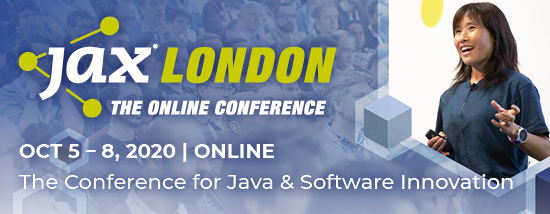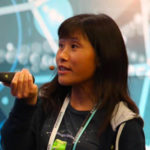A research study by The National Center for Women & Information Technology showed that “gender diversity has specific benefits in technology settings,” which could explain why tech companies have started to invest in initiatives that aim to boost the number of female applicants, recruit them in a more effective way, retain them for longer, and give them the opportunity to advance. But is it enough?
Three years ago, we launched a diversity series aimed at bringing the most inspirational and powerful women in the tech scene to your attention. Today, we’d like you to meet Dr. Denise Gosnell, Chief Data Officer, at DataStax.
Today’s Woman in Tech: Dr. Denise Gosnell, Chief Data Officer, at DataStax
 As Chief Data Officer of DataStax, Dr. Denise Gosnell applies her experiences from within the graph and machine learning industries to drive more informed decisions with data. Most recently, she published the book The Practitioners Guide to Graph Data which illustrates how to apply graph thinking to solve complex problems.
As Chief Data Officer of DataStax, Dr. Denise Gosnell applies her experiences from within the graph and machine learning industries to drive more informed decisions with data. Most recently, she published the book The Practitioners Guide to Graph Data which illustrates how to apply graph thinking to solve complex problems.
Dr. Gosnell earned her Ph.D. in Computer Science from the University of Tennessee as an NSF Fellow. Her research coined the concept “social fingerprinting” by applying graph algorithms to predict user identity from telecommunication interactions. She holds two patents on novel applications of graph technology within the healthcare industry.
When did you become interested in technology?
It happened in two parts; the first is when I found my niche topic and then the second is when I actually started coding.
The first part is kind of a funny story – thanks to my University’s registrar system, I somehow got locked out of all the required classes I needed to take for a math degree – not kidding! So rather than taking real analysis or abstract algebra, I was forced to take an elective class, and it happened to be graph theory! I’ll admit I didn’t read any of the material before the class began, and I walked into my first day of graph theory assuming we were going to be talking about data visualization – it turned out that wasn’t at all what graph theory was about!
Of course, it was actually about studying relationships between data. Before I started that class I had never considered studying data outside of a spreadsheet. I always thought data was traditional rows and columns, and this idea of studying the connections in data, honestly, felt like an epiphany moment. To this day, I can so vividly remember those five minutes that introduced me to the world of graph data. My professor, Dr. Theresa Haynes, drew a circle on the whiteboard that represented the vertex, then lines that connected to other circles that represented things like your social network, you, all your friends, and then the friends of your friends, and so-on. It was at that moment that I realised this is what I wanted to study for the rest of my life.
Then towards the end of my master’s, I received an NSF fellowship to start a PhD in computer science. I did not know how to code, didn’t know what a terminal was, and it was so scary to start a PhD in computer science and have to essentially do the full undergraduate curriculum at the same time as my grad curriculum. I really had to take a bet on myself that I could figure it out.
Thankfully I had some incredible mentors. Dr. Catherine Schuman is one of the leading computational neuroscientists, and she spent two of her summers teaching me how to code and manage memory. Honestly, if I didn’t have a mentor like Dr. Schuman. I don’t know if I would have made it.
How did you end up in your career path? What obstacles did you have to overcome?
My PhD advisor was watching me interview with all these big tech companies and suggested that big tech companies were perhaps the wrong route for me. They suggested that I meet with a gentleman called Ted Tanner, who was starting a new company and needed a data scientist to help move the startup in the right direction. The technology I used for my project was acquired by DataStax, so I followed the team because I thought that the tech was really cool. That’s a short version of how I ended up with DataStax!
In terms of the obstacles – I didn’t even know that Women in Tech was a thing until I was asked to attend a Grace Hopper conference on women in technology. I remember thinking, “Why do we need a conference just for women?”, and then it dawned on me that it’s because there really were so few of us. So, I participated in Grace Hopper conferences, and started a group at the University of Tennessee-Knoxville called Systers, which I still mentor today.
I also worked with Sheryl Sandberg and the Lean In organization to kick off Lean In across campuses. These were really great movements to be a part of, but it was also a little sad to suddenly become aware of the world I was in and the politics involved. That being said, I’m really glad that I was able to reach back and establish these networks for other women and help equip them against some of the obstacles that they might face in the industry.
Did you receive support from your family and friends? Do you have a role model?
I like to collaborate with people that I think are doing really great stuff in the industry. In the beginning, I absolutely loved working with Dr. Teresa Haynes and Dr. Debra Knisley, two leading women in graph theory who are just rockstars. They have more published papers out there than any academic in graph theory, and it’s such an honour to have them in my network.
I also worked with some incredible mentors. Dr. Chris Groer was one of the cofounders of another startup, and we worked together on identity analysis using graph structures. Dr. Michael Berry was my PhD advisor and a brilliant computer scientist to work with. Dr. Berry connected me to Ted Tanner who really lit the spark for me in having a passion for all things data and graph data and distributed technology.
At DataStax, Dr. Mathias Broecheler, Chief Technologist, has been one of the most kind collaborators that I have worked with. We wrote The Practitioners Guide to Graph Data together. Jonathan Lacefield, Senior Director of Product Management, has also been someone who supported me for so long, and has been a phenomenal mentor.
I’m really surrounded by people who support me and that’s the way I like to work.
I’m really surrounded by people who support me and that’s the way I like to work.
Did someone ever try to stop you from learning and advancing in your professional life?
Absolutely. But it’s situations rather than specific people. My career has not been this linear progression, it’s a path through forks and bumps and changes in direction. Often, people view your career through this social media timeline view of what you’ve done, but that doesn’t really explain the journey at all. Throughout my career, the big milestones have also seen me come face to face with some kind of adversity where I’ve lost everything I was working on and had to pivot out of pretty dire situations.
In 2007, the United States economy crashed right when I was getting ready to graduate from college. I had planned to be a teacher which didn’t turn out so well for me, and suddenly I’m facing graduation in a matter of weeks with no plans. That was extremely stressful. Thankfully I was able to use my network to get into grad school, and that’s where I met Dr. Haynes who introduced me to graph theory, so it somehow worked out.
Then, in 2013 I was in the middle of my PhD and had passed my proposal when Edward Snowden defected from the United States. His defection revealed all of these ways that US citizens’ data was being used to track them. My dissertation topic was tracking your identity across telecommunication networks, and I was using all of the open edge supercomputers on anonymized data to do churn detection for a large telecommunication provider in the United States. At the time, I didn’t correlate these events. I passed my proposal and then two months later, all of my data was removed and my sponsorship was revoked, so I couldn’t finish my last chapters of work.
At the time, I didn’t realise how what was essentially a marketing exercise was potentially contributing to learning how to trace identity in data. Now that I look back I can see that I was doing some really cutting edge work that could be flipped into malicious intention. It’s so important to take a step back and realise the broader application of what you’re doing or how it can be construed in a negative manner.
I had only two chapters of a dissertation completed and lost everything else overnight. I had only nine months of funding to finish, so I had to take a job whilst rewriting the last two thirds of what I was building. It was a hard stop for any kind of work that related to tracking, so I had to find another path.
What are you most proud of in your career?
What I’m most proud of is that I like what I do, that I wake up every day and I’m happy. I don’t care about follower count or how many times I’m cited. What’s important is that my work is positively influencing the world. I work with really amazing people at DataStax who genuinely uplift one another, and it’s a real joy to be a part of the team.
Why aren’t there more women in tech?
When I was at college, I don’t remember taking notice of the disproportion of women in my classes until it was pointed out to me, but I think I was so focussed on finishing my degree that perhaps I wasn’t allowing myself to pick up on any of those subtle obstructions. That alone is probably a big factor in a lot of women not choosing to pursue education or a career in tech – not seeing yourself represented in the classroom or the office can be daunting.
What I have noticed is that in a lot of these public forums around community-developed projects, the power of the keyboard versus personal communication convinces people that they can say whatever they want. This leads to a lot of toxic communication styles around collaboration and often an inability to determine intention and context.
Someone trying to help you with, say, code reviews, or a criticism of your work, might be misinterpreted as malicious. Sometimes people are going to be rude for the sake of it, and that really can be a barrier for a lot of people in the field. That lack of context and intent is something I’ve personally had to navigate as I’ve progressed – sometimes I really just need to ask them to clarify if they’re being rude or not! Thankfully, half the time, they’re not.
It’s so important to take a step back and realise the broader application of what you’re doing or how it can be construed in a negative manner.
Would our world be different if more women worked in STEM?
Absolutely, and I think it would be different both in production and in the end product. I would hypothesize that software or products that are developed with a more balanced representation of the user base would be far more beneficial to more people. With a more 50/50 distributed workforce behind the design, I imagine it would have more useful features and have a stronger focus on how the product looks, feels and operates. It’s hard to say exactly, but it kind of stands to reason that more representation of other viewpoints and priorities would equal a more fully-rounded product.
A good example might be image recognition, which is becoming the most popular kind of application for machine learning technology. Right now there’s not an equal amount of data for training these models and that leads to technology that is biased towards certain genders, races, shapes, sizes, and abilities.
What advice (and tips) would you give to women who want a tech career?
I would say that there’s going to be a style that suits you, but in my experience, the advantage of a network, asking for help, and collaborating with other people has made the world of a difference. Teaming up with the experts in my field, wanting to co-create with them, and elevate one another as we build something new has been something that I have found invaluable. So reach out, collaborate with other people, and then don’t forget to reach back as well. Networking and co-creation of others is absolutely the way to amplify a career.
More Women in Tech:
- Women in Tech: “80% of all jobs are never posted publicly”
- Women in Tech: “Women have been able to bring a new perspective to the tech industry”
- Women in Tech: “Take responsibility and ownership for your own growth”
- Women in Tech: “Celebrate your wins, big and little”
- Women in Tech: “Experiment, deliver, retrospect, and keep learning!”
For even more Women in Tech, click here
The post Women in Tech: “What’s important is that my work is positively influencing the world” appeared first on JAXenter.
Source : JAXenter
























